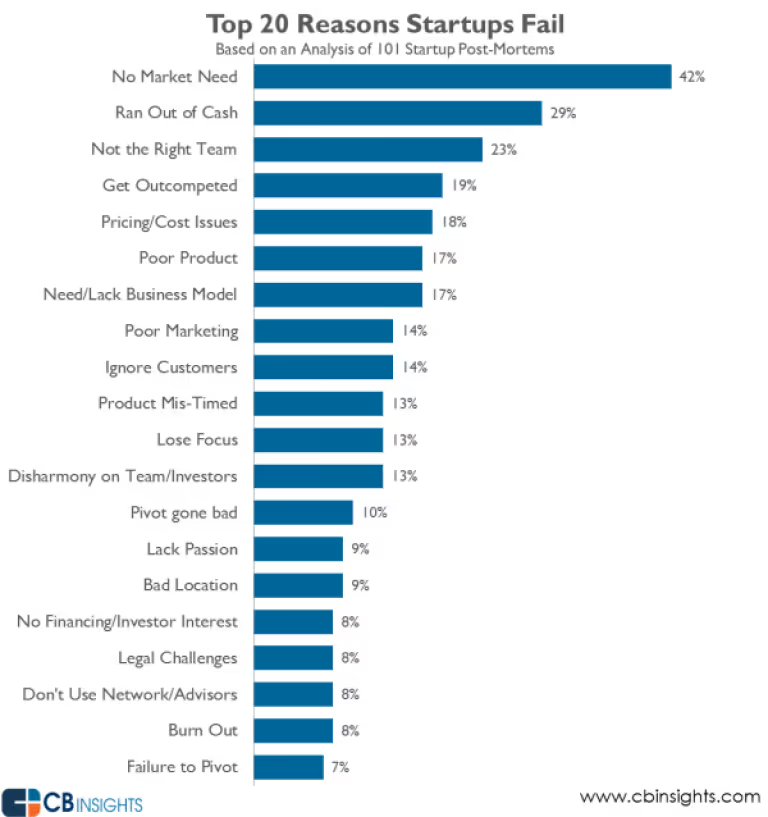Part one of our two-piece series introduced the principles of human-centered design thinking. Part two will discuss how a design thinking approach can help develop innovative solutions for the complex challenges we face as businesspeople, creatives and entrepreneurs.
Nine out of ten startups will fail. It’s the cold, hard truth. Failure post-mortem is not just a Silicon Valley cliché, but a harsh reality of what happens to great ideas. In 2014, CB Insights analyzed why 101 startup founders believe they failed. And the number one reason for failure, cited by 42% of founders, was a lack of market need for their product. Due to lofty and irrational justifications startups either build things people don’t want or develop ideas that are dismissed as a novelty. Beyond the founding idea, there are other challenges startups face, particularly in regards to building customer loyalty.

Challenges
The crowd: Other startups. Add in existing companies—who can probably beat you on price using established wholesale and manufacturing relationships in that industry—and it’s going to be next to impossible to be recognized, let alone chosen over your competition.
Lack of time: You’re busy trying to run your business, get funding, hire employees and have enough time for a vacation (just kidding). When are you going to have the time to sit down and grind out a strategic plan for all your brand’s customer touchpoints? Fancy taking up insomnia for a few years?
Lack of money: Most, if not all, of your money is probably going towards developing your product. Assuming people are compelled to buy it, that’s what is going to actually make you money. Plus, branding agencies can be pricey—there’s not much you can do if all of your funds are tied up in R&D, right?
Gaining trust: The Internet has made it easy for consumers to be cynical and suspicious of brands, and that’s a good way of keeping brands accountable. But the Internet has also made it tough for legitimate businesses to gain any trust. Before, a business needed substantial footing to be able to afford print marketing, or even TV advertising, meaning it was at least somewhat reputable. These days, it’s easy to create a website, meaning anyone could make a spam site, or even a fake brand website: what if yours doesn’t look any different?
Solutions aka How to Make an Impact
If you’re a startup, you may find challenges exciting and you’ll be driven to overcome these barriers. There are always methods to conquer the inherent potholes of entrepreneurship. A few viable models have emerged to help overcome the challenges listed above however, the ones that have did so not out of the corporate world, but the startup scene. For example, we developed our lean startup branding model, Minimum Viable Brand (MVB), after utilizing the Minimum Viable Product (MVP) model commonly practiced by budget-conscious entrepreneurs.
Another model for startups, which has emerged and has been academically validated, is co-branding with a larger existing corporation. This works to leverage existing brand equity, not to mention advertising dollars, from the bigger company. It may work for some, but not so much for those disrupting their industry and creating a headache for the existing companies.
Whichever model you choose, having consistency, quality and personality wherever your customers encounter your brand will pay off in brand equity and highly sought after Action Loyalty. Your product or service is important, but ultimately how people think and feel about your brand will be the deciding factor in a purchase.

Make a Move
Forging cohesion between all aspects of your business plan along with product/market fit is vital. If your startup is attracting attention, you must ensure that it’s from qualified visitors with a genuine interest in your product. This is where design thinking and a branding model come into play.
Approach your business with a design-centric mindset. Establish a solid base with a strong brand identity and thought-out strategy to support that influx of new prospects. Understanding the needs of your audience through design thinking is the critical foundation for solutions that solve real problems and create unforgettable brand experiences.
SOURCES
The Top 20 Reasons Startups Fail — CB Insights
Branding for Startups — Yu Dai & Alberto Pietrobon.





